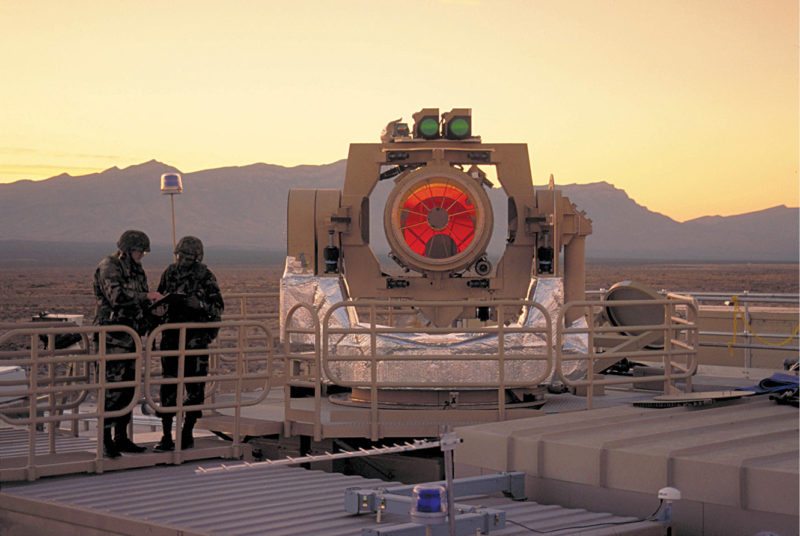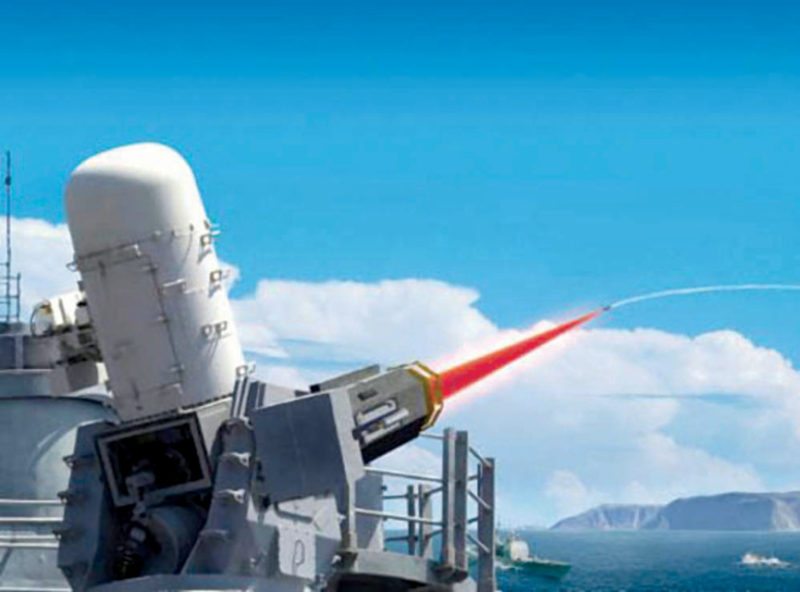In this concluding part of the article, let us wrap up by learning some more about high-energy laser weapons.
Beam combination of multiple lasers
Power scale-up to ten to hundreds of kilowatts in a single laser, maintaining the desired beam quality, has many a technological challenges to overcome. Developments in the field of beam-combination techniques have opened new avenues of building higher-power lasers than could be combined in a single laser. Combining laser output from multiple fibre lasers is an important area of relevance to high-power directed energy laser weapon systems, as it allows achieving higher output power from relatively low-power individual lasers.
Direct diode lasers, bulk solid-state lasers and fibre lasers have been experimented with in recent years to generate higher powers by combining outputs of multiple lasers of a given type. Power enhancement and beam quality issues have been studied over propagation distances in kilometre range. Three common laser beam combining techniques include spectral beam combining, coherent beam combining and incoherent beam combining.
In the case of spectral beam combining, multiple laser beams with non-overlapping optical spectra are combined by using a wavelength-sensitive beam combiner such as diffraction grating and prisms. Optical components with wavelength-sensitive transmission characteristics such as volume Bragg gratings and dichroic mirrors can also be used.
In the case of coherent beam combining, multiple lasers are combined to generate higher output powers with more or less the same beam quality as that of individual lasers. Coherent combining also preserves the spectral bandwidth.
In one method of incoherent beam combination, multiple laser beams are combined by overlapping individual laser beams on the target with a beam director consisting of independently-controlled steering mirrors. Adaptive optics may be used to compensate for the distortions caused by atmospheric turbulence. This technique is relatively much simpler than other beam-combining techniques including spectral and coherent beam combining. It does not require phase locking or polarisation locking of individual lasers and its power can be readily scaled up for directed energy weapon applications.
Representative directed energy laser weapon systems
Presently, a large number of directed energy laser weapon systems are reported to be under development and upgradation. Some of these are experimental, some technology demonstrators, while others are being upgraded and ruggedised to become realistic battlefield weapon systems in the near future.
Some of the more talked about laser weapon systems include high-energy laser system developed by Diehl and LFK of Germany, general-area defence integrated anti-missile laser system from TRW, mid infrared chemical laser from TRW, high-energy laser weapon system from TRW, Boeing’s airborne laser and advanced tactical laser, tactical high-energy laser, mobile tactical high-energy laser, Raytheon’s Laser Phalanx and laser weapon system.
High-energy laser, jointly developed by two German companies Diehl and LFK, is a short-range tracked vehicle-mounted system for use as an air-defence system against low-flying, high-performance aircraft, missiles and attack helicopters. The system is configured around a gas dynamic CO2 laser emitting at 10.6 microns. It has associated target-acquisition and tracking sensors.
Another air-defence laser system is TRW’s general-area defence integrated anti-missile laser system. This system, too, is a short-range complement to surface-to-air missile defence designed to engage discrete ballistic threats at longer ranges. The system generates a 400kW laser beam, which is delivered through a 0.7-metre beam pointer/tracker.
One of the very early directed energy laser systems, a technology demonstrator, is TRW’s mid infrared chemical laser. It is a 2.2MW CW deuterium-fluoride laser with a maximum lasing duration of 70 seconds. It uses a 1.8-metre Sealite pointing and tracking device. The system was reported to carry out trials against different types of targets at White Sands Missile Range in New Mexico. In one of the tests conducted in 1996, a small fraction of laser power was used to destroy a 122mm short-range artillery rocket in flight. The laser beam was locked to the target for 15 seconds. It is also reported to have been tested against sea-skimming missiles.
Yet another recent system from TRW is high-energy laser weapon system, which is again a chemical laser using ethylene, hydrogen and fluorinated nitrogen as the active medium. The system is based on their earlier experience gained from building mid-infrared chemical laser. The system has an integral electro-optic tracker.
Another laser based directed energy weapon system in serious contention till recent past, particularly for operation from an aerial platform, is the famous airborne laser. It uses a 1.2-megawatt chemical oxy-iodine laser emitting at 1.315 microns, generated by six chemical oxy-iodine laser modules of 200 kilowatts each. It is configured on Boeing 747-400 freighter aircraft (Fig. 10).

Airborne laser is capable of destroying a ballistic missile in boost phase. In operation, the aircraft patrols friendly air space. After an enemy missile launch is detected by a variety of sensors, this information is relayed to the aircraft configured as high-power laser system for further action.
Advance tactical laser uses 80kW chemical oxy-iodine laser and is mounted on a modified Boeing C-130H Hercules aircraft, with the most obvious visual difference being a rotating turret protruding from the aircraft’s underside through a hole. This chemical laser is similar to the one developed for Airborne Laser programme with much lower output power. Advance tactical laser is envisioned to offer mobility of a small aircraft, high-resolution imagery for target identification and the ability to localise damage to a small area of less than 30.5cm (1-foot) in diameter from a range of eight to ten kilometres.
Another well-known laser based DEW system is Northrop Grumman’s tactical high-energy laser. The laser is built in two configurations: baseline static high-energy laser and relocateable mobile version mobile tactical high-energy laser.
Tactical high-energy laser systems (Fig. 11) are point defence weapon systems designed to engage and destroy artillery rockets, artillery shells, mortar rounds and low-flying aircraft. The system uses a deuterium fluoride laser operating at 3.8µm. Tactical high-energy laser demonstrator was successfully tested repeatedly between 2000 and 2004, destroying a number of 122mm and 160mm Katyusha rockets, multiple artillery shells and mortar rounds, including a salvo attack by mortar.

Space based laser is the ultimate objective of US-directed energy laser programme. It is proposed to be configured around 20MW hydrogen fluoride laser operating at 2.7µm. It is being designed to intercept intercontinental ballistic missiles and other strategic and tactical missiles. It is proposed to deploy the system in 800km to 1300km orbit. The expected target engagement range is 4000km to 12,000km.
Several directed energy laser systems based on solid-state and fibre lasers are being developed and tested for tactical mission needs ranging from ordnance neutralisation to anti-missile and anti-RAM applications.

Raytheon has developed and successfully tested a directed energy laser system called Laser Phalanx (Fig. 12) employing a 20kW industrial fibre laser. The system has been successfully demonstrated against a static mortar from a distance of 0.5 kilometres.
Raytheon has also successfully tested a ship-mounted solid-state laser weapon system (Fig. 13) to shoot four drones.

Laser-induced plasma channel weapons
A laser-induced plasma channel weapon is conceptually different from conventional high-energy laser weapons. It makes use of an ultra-short laser pulse to create a highly-conducting plasma channel between the laser and the intended target. It is designed to take out targets that conduct electricity better than air or ground surrounding these.
This conducting plasma follows the path of the laser and therefore can be directed to different targets by steering the laser beam. When the plasma comes in contact with a high-voltage source, a high-voltage current discharge travels down the plasma channel and then through the target to ground, thereby causing severe damage to the target—similar to what would have been caused had there been a lightning strike.
The concept behind formation of plasma channel is as follows: A pulsed laser of even a modest energy producing ultra-short laser pulses is capable of generating gigantic peak power of the order of tens of gigawatts. The electromagnetic field produced due to the intense laser beam rips off electrons from the air molecules, thereby ionising the surrounding air and creating plasma. For high-intensity laser pulses, air can act like a lens. The laser focuses on itself in air, confining light to a small-diameter filament.
Laser-induced plasma channel weapons behave like a lightning strike that always tries to follow the path of least resistance while travelling from cloud to ground. Plasma channel conducts electricity much better than un-ionised air. If the plasma channel comes near a high-voltage source, electrical energy travels down the ionised conduit. When a laser-induced plasma channel weapon is used on a target such as a vehicular platform, a person or unexploded ordnance, high-voltage current discharges through the path of least resistance to ground, potentially disabling the vehicle or person, and initiating ordnance detonation.
Laser-induced plasma channel weapon hardware mainly comprises a laser capable of generating ultra-short pulses of the order of a few picoseconds and a power source to drive both laser and high-voltage discharge. But there are many technological challenges to be overcome. These include synchronising the laser with the high voltage, ruggedising the device to survive under extreme environmental conditions of an operational environment, and powering the system for extended periods of time.
Laser-induced plasma channel devices can have a variety of applications. These can be used to kill or incapacitate human targets through electric shock. These can also damage, disable and destroy electronic devices.
Laser-induced plasma channels may also be used for a variety of experiments, including study of lightning discharges, forcing lightning discharges to occur at safe time and place during thunderstorms, inducing thunderheads that deliver a precise lightning strike on to a ground target triggered by an airborne laser, and harvesting lightning energy for power generation by directing it to a terrestrial collection station.
Dr Anil Kumar Maini is former director, Laser Science and Technology Centre, a premier laser and optoelectronics research and development laboratory of Defence Research and Development Organisation of Ministry of Defence






A few months ago at 4am, in Chippenham UK, l experienced green lightning.This blinded me as it was extremely bright, and affected my breathing.It was not normal lightning, although was accompanied by thunder.Was this an experiment with a laser weapon.